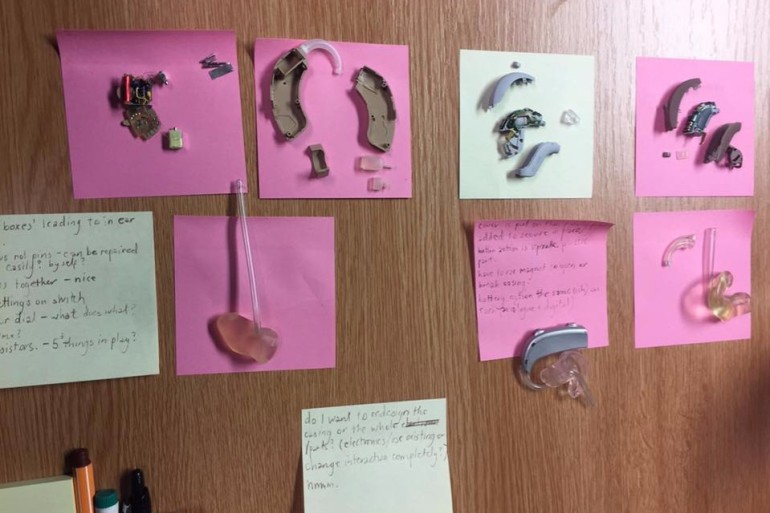
I realise this title had the potential to be mildly witty if I intended to write an in depth cultural analysis of the hearing aid. However this time I’m literally taking them apart and looking at their insides. I wanted to do this for a number of reasons. Mainly curiosity and I believe that seeing the electronics (even if you’re not sure exactly what does what) tends to de-mystify them.
I’ve had these hearing aids for a little while now but have been stalling myself from taking them apart and trying to understand how they work. I’d used the excuse that I didn’t have the correct tools to do so. But when my flatmate decided to do some DIY in/on the flat last Sunday afternoon, I noticed she had just the teeny tiny screwdrivers that I required, and I could put it off no longer.
The first hearing aid I took apart is an analogue hearing aid. It was surprisingly easy to do so, only four screws hold the parts together (admittedly tiny fiddly screws, but screws nonetheless).
Now, having never used a hearing aid I’m not exactly sure what the different functions mean and do. (Except that is, from what I’ve read in my research and seen diagrams of.) So many of my observations and deductions may cause wearers of hearing aids to laugh at my ignorance. But, I think they are valid observations because every hearing aid wearer, at some point, didn’t wear a hearing aid and would be looking at this object with fresh, naive eyes. (And probably an instruction manual, which I was not provided.) So although hearing aids are complex, they should be usable. So my observations should be considered more as commentary as to how intuitive the design of these objects is.
The analogue ones are almost double the size of the digital ones. I presume either because their electronic parts require more space or because the digital ones are newer and follow a trend in technology to try and make things smaller. This is particularly interesting in the context of hearing aid technology. I wonder, are wearers asking for smalling hearing aids? Who made that design decision and why?
As a side bar: I’m led to believe that analogue hearing aids can be considered “old fashioned” and many users have made the change from analogue to digital. For those who take the NHS route, I’m not sure if the decision to change is by choice. I imagine long term analog users would much prefer to continue using analog aids. Although analogue hearing aids are still offered by private suppliers and are the cheaper option of the two.
After sitting a medium-sized one (by my stock) behind my ear for just over an hour, I can confirm that I was aware of it’s presence most of the time. It wasn’t uncomfortable, but I could feel it pushing the top flap of my ear (not the approved medical term) just slightly out. When I removed it, it reminded me of the sensation you get letting your hair down after it being in a pony tail. Of course this hearing aid is probably not my size. So it’d be untrue to say this sensation is anything but my own small experience. I wonder if these are objects that become more comfortable with wear, like a pair of hard shoes that need to be broken in? Or if they are intended to be comfortable from the first wear.
From the larger analogue to the smallest digital there is a noticeable difference in weight. However to hold in your hand, they don’t feel heavy at all. Without the ear mold attached, actually quite similar to the weight of a sharpie. (Note to self: bring in scales and weigh them, rather than using desktop items as a means of comparison.)
Both of these hearing aids contain somewhat complex looking electronics inside. I recognise resistors, coils and various button/switch controls. The digital hearing aids electronics are far more compact than that of the analogue. (However, the older of the two analogue designs has a particularly enjoyable switch that has the most fantastic tension to click up or down. I spent five minutes just doing this motion.) Both digital devices have two controls, one that seems to allow an up/down motion and the other a simple push button. Both analogue devices also have two controls, one a spin wheel numbered from 1-4 and either the click switch (my favorite part) or a push button. So, I imagine the 1-4 setting on the analogue devices control either preset functions or volume. I wonder, why four on this scale? All of the controls made me think of the word, fiddly. I realise that scale may limit user interaction. How do elderly users find these controls in terms of ease of use?
In terms of casing, the analogue ones were satisfying to open. A two part casing allowed for a lovely ‘click’ as it released to revealed the inners. The digital ones felt quite similar to opening a pistachio nut. Tension created by pins holding the casing in place, meant that both digital casings cracked or warped when removed. Which is interesting in terms of repairs. Was this just my bad technique or will the casings need to be replaced if anything internal needs fixing? However the digitals casing could be considered more sleek whereas the analogue ones do look quite “boxy.”
One of the first plans I have is to look at re-creating some of these casings (or alterations of them) in different materials. As these are all made out of plastic, some questions that it’s important to ask are, why is plastic the preferred material? Why these colours? And what possibilities are there to improve the wearers aesthetic opinion of hearing aids?



definitely keep your blog going!
LikeLiked by 1 person